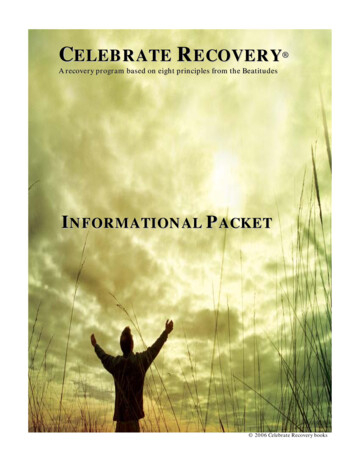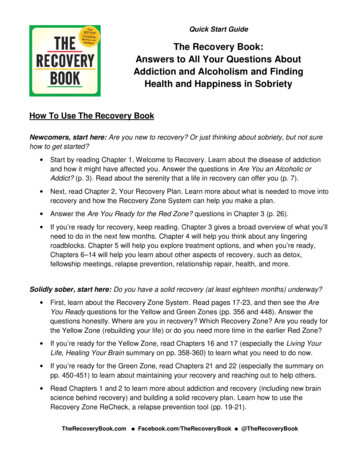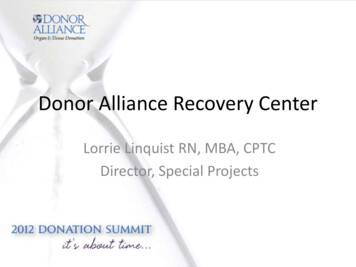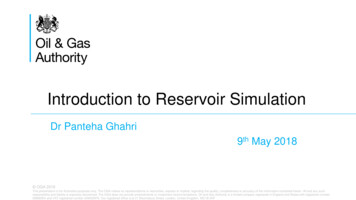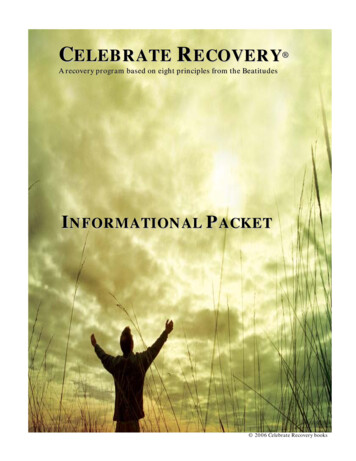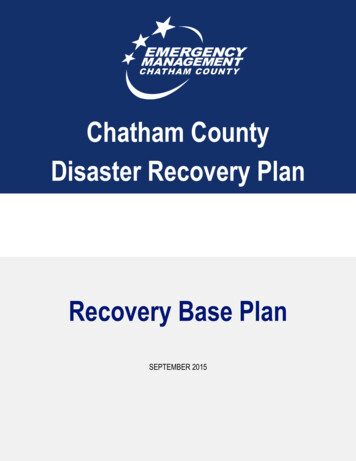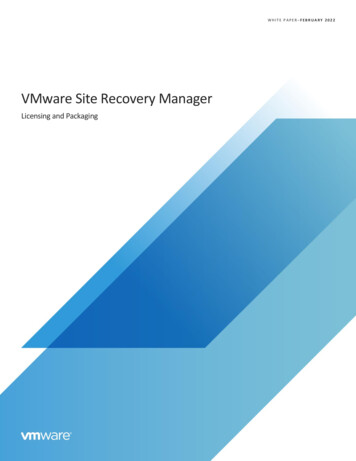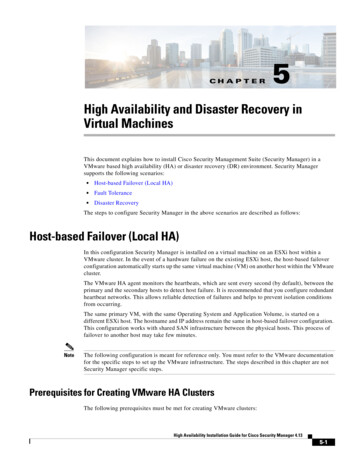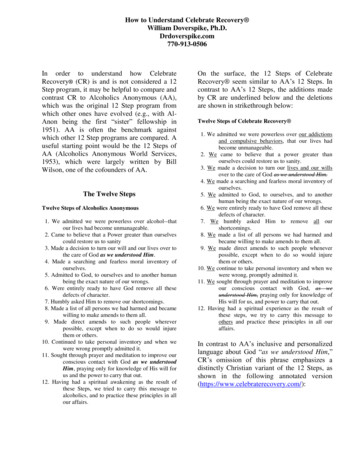
Transcription
How to Understand Celebrate Recovery William Doverspike, Ph.D.Drdoverspike.com770-913-0506In order to understand how CelebrateRecovery (CR) is and is not considered a 12Step program, it may be helpful to compare andcontrast CR to Alcoholics Anonymous (AA),which was the original 12 Step program fromwhich other ones have evolved (e.g., with AlAnon being the first “sister” fellowship in1951). AA is often the benchmark againstwhich other 12 Step programs are compared. Auseful starting point would be the 12 Steps ofAA (Alcoholics Anonymous World Services,1953), which were largely written by BillWilson, one of the cofounders of AA.The Twelve StepsTwelve Steps of Alcoholics Anonymous1. We admitted we were powerless over alcohol--thatour lives had become unmanageable.2. Came to believe that a Power greater than ourselvescould restore us to sanity3. Made a decision to turn our will and our lives over tothe care of God as we understood Him.4. Made a searching and fearless moral inventory ofourselves.5. Admitted to God, to ourselves and to another humanbeing the exact nature of our wrongs.6. Were entirely ready to have God remove all thesedefects of character.7. Humbly asked Him to remove our shortcomings.8. Made a list of all persons we had harmed and becamewilling to make amends to them all.9. Made direct amends to such people whereverpossible, except when to do so would injurethem or others.10. Continued to take personal inventory and when wewere wrong promptly admitted it.11. Sought through prayer and meditation to improve ourconscious contact with God as we understoodHim, praying only for knowledge of His will forus and the power to carry that out.12. Having had a spiritual awakening as the result ofthese Steps, we tried to carry this message toalcoholics, and to practice these principles in allour affairs.On the surface, the 12 Steps of CelebrateRecovery seem similar to AA’s 12 Steps. Incontrast to AA’s 12 Steps, the additions madeby CR are underlined below and the deletionsare shown in strikethrough below:Twelve Steps of Celebrate Recovery 1. We admitted we were powerless over our addictionsand compulsive behaviors, that our lives hadbecome unmanageable.2. We came to believe that a power greater thanourselves could restore us to sanity.3. We made a decision to turn our lives and our willsover to the care of God as we understood Him.4. We made a searching and fearless moral inventory ofourselves.5. We admitted to God, to ourselves, and to anotherhuman being the exact nature of our wrongs.6. We were entirely ready to have God remove all thesedefects of character.7. We humbly asked Him to remove all ourshortcomings.8. We made a list of all persons we had harmed andbecame willing to make amends to them all.9. We made direct amends to such people wheneverpossible, except when to do so would injurethem or others.10. We continue to take personal inventory and when wewere wrong, promptly admitted it.11. We sought through prayer and meditation to improveour conscious contact with God, as weunderstood Him, praying only for knowledge ofHis will for us, and power to carry that out.12. Having had a spiritual experience as the result ofthese steps, we try to carry this message toothers and practice these principles in all ouraffairs.In contrast to AA’s inclusive and personalizedlanguage about God “as we understood Him,”CR’s omission of this phrase emphasizes adistinctly Christian variant of the 12 Steps, asshown in the following annotated version(https://www.celebraterecovery.com/):
Understanding Celebrate Recovery 2Annotated Twelve Steps of Celebrate Recovery 1. We admitted we were powerless over our addictions andcompulsive behaviors, that our lives had becomeunmanageable.“I know that nothing good lives in me, that is, in mysinful nature. For I have the desire to do what is good,but I cannot carry it out” (Romans 7:18 NIV).2. We came to believe that a power greater than ourselvescould restore us to sanity.“For it is God who works in you to will and to actaccording to his good purpose” Philippians 2:13NIV).3. We made a decision to turn our lives and our wills over tothe care of God.“Therefore, I urge you, brothers, in view of God'smercy, to offer your bodies as living sacrifices, holyand pleasing to God - this is your spiritual act ofworship” (Romans 12:1 NIV).4. We made a searching and fearless moral inventory ofourselves.“Let us examine our ways and test them, and let usreturn to the Lord” (Lamentations 3:40 NIV).5. We admitted to God, to ourselves, and to another humanbeing the exact nature of our wrongs.“Therefore confess your sins to each other and prayfor each other so that you may be healed” (James5:16a NIV).6. We were entirely ready to have God remove all thesedefects of character.“Humble yourselves before the Lord, and he will liftyou up” (James 4:10 NIV).7. We humbly asked Him to remove all our shortcomings.“If we confess our sins, he is faithful and will forgiveus our sins and purify us from all unrighteousness” (1John 1:9 NIV).8. We made a list of all persons we had harmed and becamewilling to make amends to them all.“Do to others as you would have them do to you”(Luke 6:31 NIV).9 We made direct amends to such people whenever possible,except when to do so would injure them or others.“Therefore, if you are offering your gift at the altarand there remember that your brother has somethingagainst you, leave your gift there in front of the altar.First go and be reconciled to your brother; then comeand offer your gift” (Matthew 5:23-24 NIV).10. We continue to take personal inventory and when we werewrong, promptly admitted it.“So, if you think you are standing firm, be careful thatyou don’t fall!” (1 Corinthians 10:12 NIV).11. We sought through prayer and meditation to improve ourconscious contact with God, praying only forknowledge of His will for us, and power to carry thatout.“Let the word of Christ dwell in you richly.”(Colossians 3:16a NIV).12. Having had a spiritual experience as the result of thesesteps, we try to carry this message to others andpractice these principles in all our affairs.“Brothers, if someone is caught in a sin, you who arespiritual should restore them gently. But watchyourself, or you also may be tempted” (Galatians 6:1NIV).The Twelve TraditionsMajor differences between AA and CR are seengovernance of groups and meetings. Whereasvirtually all 12-Step fellowships follow somevariation of AA’s Twelve Traditions, CR omitsthese traditions altogether.Twelve Traditions of Alcoholics Anonymous1. Our common welfare should come first; personalrecovery depends upon A.A. unity.2. For our group purpose there is but one ultimateauthority—a loving God as He may expressHimself in our group conscience. Our leadersare but trusted servants; they do not govern.3. The only requirement for A.A. membership is adesire to stop drinking.4. Each group should be autonomous except in mattersaffecting other groups or A.A. as a whole.5. Each group has but one primary purpose—to carry itsmessage to the alcoholic who still suffers.6. An A.A. group ought never endorse, finance, or lendthe A.A. name to any related facility or outsideenterprise, lest problems of money, property,and prestige divert us from our primary purpose.7. Every A.A. group ought to be fully self-supporting,declining outside contributions.8. Alcoholics Anonymous should remain forever nonprofessional, but our service centers mayemploy special workers.9. A.A., as such, ought never be organized; but we maycreate service boards or committees directlyresponsible to those they serve.10. Alcoholics Anonymous has no opinion on outsideissues; hence the A.A. name ought never bedrawn into public controversy.11. Our public relations policy is based on attractionrather than promotion; we need always maintainpersonal anonymity at the level of press, radio,and films.12. Anonymity is the spiritual foundation of all ourtraditions, ever reminding us to place principlesbefore personalities.Eight Principles of Celebrate Recovery The Eight Principles of CR are not traditions but ratherare a condensed restatement of the 12 Steps: Principle 1(Step 1), Principle 2 (Step 2), Principle 3 (Step 3),Principle 4 (Steps 4 and 5), Principle 5 (Steps 6 and 7),Principle 6 (Steps 8 and 9), Principle 7 (Steps 10 and 11),and Principle 8 (Step 12). For reference, the EightPrinciples of CR are contained in the Appendix of thisarticle.
Understanding Celebrate Recovery 3HistoryPurposeAA: The founding of AA is considered to be the day thatBill Wilson and Dr. Robert Holbrook Smith (Dr. Bob)were introduced to each other by an Oxford Groupmember named Henrietta Sieberling in Akron, Ohio. Dr.Bob and his wife Anne arrived at Henrietta’s door at 5:00PM. Henrietta discreetly whisked off the two men to thelibrary. Bob’s words were, “Mighty glad to meet you,Bill. But it happens I can’t stay long; five or ten minutesat the outside.” With six month’s sobriety, Bill laughedand observed, “Guess you’re pretty thirsty, aren’t you?”Bob’s rejoinder was, “Well, maybe you do understandthis drinking business after all.” This dialogue began atalk that lasted several hours on that evening. “I knownow that I’m not going to take another drink,” said Bill,“and I’m grateful to you.” Bill stayed with Dr. Bob forthe next three weeks. Through their friendship, Dr. Bobgained sobriety. Dr. Bob’s first “dry date” of June 10,1935 is officially counted as the beginning of AlcoholicsAnonymous. Bill and Bob began working with otheralcoholics, helping them achieve sobriety one day at atime. Four years later, they published the book AlcoholicsAnonymous, which explained their program of recovery.AA: Each group has but one primary purpose---to carryits message to the alcoholic who still suffers (Tradition5). This tradition is described as AA’s “singleness ofpurpose.”Although AA history archivists date Dr. Bob’s actual lastdrink on or around June 17, 1935 (Gary N., personalcommunication), AA Founder’s Day is by traditionconsidered to be June 10, 1935. AA historians know thatHenrietta Sieberling had arranged for Bill to meet Dr.Bob on Mother’s Day, May 12, 1935. However, whenBill and Henrietta went to the home of Dr. Bob on thatoccasion, he was passed out on the floor—thusnecessitating the follow-up visit when he was notintoxicated.CR: According to public information available on itswebsite, Celebrate Recovery started in 1991 atSaddleback Church in Lake Forest, California. At thattime, the church was meeting at a high schoolgymnasium. John Baker wrote Pastor Rick Warren the“now-famous, concise, 13-page, single-spaced” letteroutlining the vision God had given John for CelebrateRecovery. After reading John’s letter, Pastor Rick said,“Great, John — go do it!” The first night, 43 peopleattended, and Celebrate Recovery was born. Beginningwith only four Open Share Groups — Men’s andWomen’s Chemical Dependency and Men’s andWomen’s Codependency — the ministry has grown toover 14 groups today. Over 27,000 people have gonethrough the program at Saddleback Church. Many ofthem are now serving in Celebrate Recovery and theChurch. Celebrate Recovery is the number one outreachministry at Saddleback Church, with over 70 percent ofits members now coming from outside the church.CR: The focus is on “hurts, hang-ups, and habits.”According to its website, CR is for people who want todeal with “Dependency on alcohol or drugs,pornography, low self-esteem, need to control,depression, anger, co-dependency, depression, fear ofrejection, fear of abandonment, perfectionism, aterecovery.com/).Membership RequirementsAA: “The only requirement for membership is a desire tostop drinking” (Tradition 3).CR: “We expect each group to be accountable to Christ,the local church, and the model of Celebrate ww.celebraterecovery.com/).AffiliationAA: “AA is not allied with any sect, denomination,politics, organization or institution” (AA Preamble ).CR: “A Christ-centered recovery program at SaddlebackChurch” (https://www.celebraterecovery.com/).AuthorityAA: “For our primary group purpose, there is but oneultimate authority---a loving God as He may expressHimself in our group conscience” (Tradition 2).CR: Celebrate Recovery requires that, if the CelebrateRecovery name is used, then certain guidelines must bemaintained” (https://www.celebraterecovery.com/).LeadershipAA: “Our leaders are but trusted servants; they do notgovern” (Tradition 2).CR: “Program uses Leaders and teachers. The LargeGroup lessons are taught from the Leader’s Guide”(https://www.celebraterecovery.com/).
Understanding Celebrate Recovery 4Approved LiteratureSupplemental LiteratureAA: The definitive text is the book AlcoholicsAnonymous, commonly known as the Big Book. ManyAA members have said that groups are guided by AA’sConference-Approved Literature (CAL) and that“everything else is just someone’s opinion.” CAL refersto audiovisual or written material approved by the AAGeneral Service Conference (GSO) for publication by theAA GSO. Books, brochures, pamphlets, and audiovisualmaterials that are published by AA will have thestatement, “This is A.A. General Service Conferenceapproved literature” printed on the item. However, theterm CAL does not imply Conference disapproval ofother material about AA, nor does AA try to tell anyindividual member what he or she may or may not read.The AA General Service Conference meets once a year.The pamphlets, booklets and materials approved forpublication by AA World Services (AAWS) out of thisprocess go through a thorough process of review. Toensure the continued integrity of AA literature, and tomake sure the AA program will not be distorted ordiluted, permission to reprint must be obtained fromAAWS in writing. At the same time, AA newsletters,bulletins, and meeting lists have blanket permission touse the material, providing proper credit is given toensure that the copyrights of AA literature is protected.When AA’s copyrighted literature is reprinted, it mustshow one of the following statements: (1) “Reprintedwith Permission of AA World Services, Inc.”, or (2)“Reprinted with permission of the AA Grapevine, Inc.”AA: Although some AA members occasionally bringother materials into meetings, the only commonly citedmaterials are from the book Twelve Steps and TwelveTraditions and The Grapevine, which is known as TheInternational Journal of Alcoholics Anonymous. The AAPreamble is actually copyrighted by The Grapevine, Inc.Many thousands of books, articles, pamphlets,newsletters, tapes, and videos used by AA members andgroups are not Conference-approved literature. Forexample, Twenty-Four Hours a Day, published byHazelden since 1954, was the second largest best seller(behind the Big Book) to AA members for many years.Twenty-Four Hours a Day is used by AA groups inmeetings and is clearly not Conference-approvedliterature. As a general guideline, what any AA memberreads is no business of GSO or of the Conference(GSOAA, 1978, p. 6).While statements from the GSO on this topic have beenscarce, the GSO did issue a statement in a 1978 Box 459Newsletter:CR: “We strongly encourage the use of the CelebrateRecovery Study Bible. It is the only Bible that directlycorresponds to the Celebrate Recovery curriculum. Wedesigned the Celebrate Recovery Study Bible to workwith the resources developed and tested in the nationaland international ministry of Celebrate Recovery”(https://www.celebraterecovery.com/). On its website,CR quotes Bible verses—only from the NewTestament—from the New International Version (NIV)of the Bible.“It [Conference Approved] does not mean theConference disapproves of any otherpublications. Many local A.A. central officespublish their own meeting lists. A.A. as a wholedoes not oppose these, any more than A.A.disapproves of the Bible or books on health orany other publications from any source thatA.A.’s find helpful. What any A.A. memberreads is no business of G.S.O., or of theConference, naturally. (GSOAA, 1978, p. 6)CR: “The Celebrate Recovery Bible and CelebrateRecovery curriculum consisting of the Leader’s Guide,four Participant’s Guides, and the Celebrate ww.celebraterecovery.com/).CR: Life’s Healing Choices is part of the CelebrateRecovery curriculum.Holy BibleAA: Some verses of the Holy Bible are paraphrased inthe Big Book of Alcoholics Anonymous. Because the BigBook was originally published in 1939, verses quotedfrom the Bible are from the King James Version.However, for AA members who use Bibles, any versionis considered acceptable.SalesAA: All materials available through public access anddownloadable at no cost. The Big Book of AA isavailable for free at any meeting and on the internet.CR: “Items produced for commercial sale using theCelebrate Recovery name or any part of the CelebrateRecovery curriculums is strictly prohibited. This is ebraterecovery.com/).
Understanding Celebrate Recovery 5Meeting FormatOnline FormatAA: Alcoholics Anonymous designates meetings asOpen, Closed, Speaker meetings, Discussion meetings,Big Book study meetings, and Step meetings.AA: Even before the pandemic, AA online meetingshave been available 24 hours a day for seven day a week.Currently, many meetings take place by Zoom.CR: All CR groups use the Small Group Guidelines leback.com/), there are three maincomponents that make up the Celebrate Recoveryprogram.CR: Prior to the pandemic, there were no online CRgroups. Currently, there are some Step Groups and ShareGroups meeting by ZoomLarge Group: Everyone meets together to heareither a recovery centered Teaching or apersonal Testimony of a changed life. Thisgroup is considered a “shoulder to shoulder”experience.AA: Made a decision to turn our will and our lives overto the care of God as we understood Him (Step 3).Open Share: This time involves breaking intoseparate gender and issue specific groups whereeach person is safe to share their struggles andvictories with others who share their similarhurts, hang-ups and habits. These groups areconsidered a “face to face” experience.Understanding of GodStep Study: It has been said that “you go to ameeting to feel better, but you work the steps toget better.” Step Studies are a safe place to workthrough the Jesus-centered 12 Steps in a genderspecific group. They are a minimum one-yearcommitment and meet on different nights of theweek. It’s a place where the “why” behindaddictions and behavior can finally beuncovered and freedom can be found. StepStudies are considered a “heart to heart”experience.Age LimitsAA: Any age is allowed.CR: A person must be at least 18 years of age to attend aOne Day seminar.GenderAA: Depending on what the Group Conscience hasdecided for the group (Tradition Two), AA meetings canbe mixed or gender specific. Transgender individuals arewelcome to attend their meetings of preference.CR: All Small Groups and Open Share meetings aregender specific (https://www.celebraterecovery.com/).Higher PowerCR: Jesus Christ is the one and only Higher Power(https://www.celebraterecovery.com/).AA: It was in January 1938 that a former atheist namedJim B. gave AA the phrase “God as we understand Him.”The phrase originated with Rev. Sam Shoemaker (18931963), DD, DST, an Episcopal priest who was rector ofCalvary Church in New York City, and head of theOxford Group in the United States. Considered one of thebest preachers of his era, Shoemaker’s sermons weresyndicated for distribution by tape and radio networks fordecades. He also ran Calvary Rescue Mission, developedthe Work at Faith program, and focused on one’s ownunderstanding of God. His interdenominational focus andthe Oxford Group were significant influences for thefounders of AA. In his book Children of the SecondBirth, Shoemaker describes stories of men and womenwhose lives were changed by turning them over to God.In one story told by Shoemaker, a man said that he would“surrender as much of himself as he could, to as much ofChrist as he understood” (1927, p. 25). Several pageslater, Shoemaker recalls, “So they prayed together,opening their minds to as much of God as he understood”(Shoemaker, 1927, p. 47, italics added). Shoemakerbelieved that any honest person could begin the spiritualexperiment by surrendering “as much of himself as hecan, to as much of Christ as he understands” (1965, p.76).CR: “Our prayer is that Celebrate Recovery will create abridge to the millions of people who are familiar with thesecular 12 Steps (I acknowledge the use of some materialfrom the 12 Suggested Steps of Alcoholics Anonymous)and in so doing, introduce them to the one and only trueHigher Power, Jesus Christ. Once they begin thatrelationship, asking Christ into their hearts as Lord andSavior, true healing and recovery can begin!”(https://www.celebraterecovery.com/).
Understanding Celebrate Recovery 6AnonymityReferencesAA: In Alcoholics Anonymous, “Anonymity is thespiritual foundation of all our traditions, ever remindingus to place principles before personalities” (Tradition 12).Alcoholics Anonymous World Services. (1953/2010).Twelve steps and twelve traditions. New York,NY: Author.Copyrighted in 1952 by The A.A. Grapevine,Inc. and Alcoholics Anonymous Publishing(now known as Alcoholics Anonymous WorldServices, Inc.), the first printing of the book wasin April 1953.CR: In Celebrate Recovery, anonymity may not exist formembers of CR who may also be members of the churchwhere CR groups take place.WebsitesAA: Alcoholics Anonymous uses an organization (.org)domain for its official website:https://aa.org/Baker, J. (2005). Celebrate Recovery leader’s guide: Arecovery program based on eight principlesfrom the Beatitudes. Grand Rapids, MI:Zondervan Publishing House.CR: Celebrate Recovery uses a commercial (.com)domain for its official website:https://www.celebraterecovery.com/General Service Office of Alcoholics Anonymous.(1978). Box 459: News and Notes from theGeneral Service Office of A.A. 23(4), 1-9.AppendixEight Principles of Celebrate Recovery 1. Realize I’m not God; I admit that I am powerless tocontrol my tendency to do the wrong thing andthat my life is unmanageable. (Step 1)2. Earnestly believe that God exists, that I matter to Himand that He has the power to help me recover.(Step 2)3. Consciously choose to commit all my life and will toChrist’s care and control. (Step 3)4. Openly examine and confess my faults to myself, toGod, and to someone I trust. (Steps 4 and 5)5. Voluntarily submit to any and all changes God wantsto make in my life and humbly ask Him toremove my character defects. (Steps 6 and 7)6. Evaluate all my relationships. Offer forgiveness tothose who have hurt me and make amends forharm I’ve done to others when possible, exceptwhen to do so would harm them or others.(Steps 8 and 9)7. Reserve a time with God for self-examination, Biblereading, and prayer in order to know God andHis will for my life and to gain the power tofollow His will. (Steps 10 and 11)8. Yield myself to God to be used to bring this GoodNews to others, both by my example and mywords. (Step 12)Hazelden Foundation. (1954/1975). Twenty-Four hours aday. New York, NY: HarperCollins Publishers.This book is a Hazelden Meditation with aCopyright 1975 by the Hazelden Foundationin Center City, Minnesota. The firstHarperCollins paperback edition was publishedin 1992.Shoemaker, S. M. (1927/2009). Children of the secondbirth: What we used to be like, what happened,and what we are like now. Republished by CarlPalmieri (Editor). Charleston, SC: BookSurgePublishing.Shoemaker, S. M. (1965). Extraordinary living forordinary men. Grand Rapids, MI: Zondervan.Copyright 2020 by William F. Doverspike, Ph.D.Content last updated 2021The correct citation for this article is Doverspike, W. F.(2020). How to understand Celebrate Recovery.http://drwilliamdoverspike.com/
gymnasium. John Baker wrote Pastor Rick Warren the "now-famous, concise, 13-page, single-spaced" letter outlining the vision God had given John for Celebrate Recovery. After reading John's letter, Pastor Rick said, "Great, John — go do it!" The first night, 43 people attended, and Celebrate Recovery was born.
